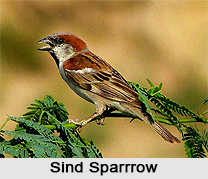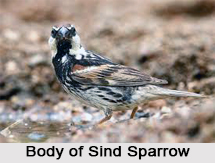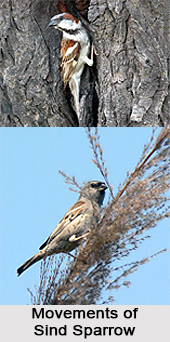 Sind Sparrow is an Indian Bird that bears a scientific name "Passer pyrrhonotus" widely concentrated in the Indian jungles of Punjab, Haryana, Rajasthan, Chandigarh and Bihar.
Sind Sparrow is an Indian Bird that bears a scientific name "Passer pyrrhonotus" widely concentrated in the Indian jungles of Punjab, Haryana, Rajasthan, Chandigarh and Bihar.
Category of Sind Sparrow
Sind Sparrow is a passerine bird of the sparrow family Passeridae, found around the Indus Valley Region in South Asia. Sind Sparrow is also known as the jungle, Sind Jungle, or rufous-backed sparrow.
Plumage of Sind Sparrow
It is very similar to the related house sparrow. It is smaller and has distinguishing plumage features. As in the house sparrow, the male has brighter plumage than female and young birds, including black markings and a grey crown. Distinctively, the male Sind sparrow has a chestnut stripe running down its head behind the eye, and the female has a darker head than other sparrow species do.
Vocals of Sind Sparrow
The main vocalisations of Sind Sparrow are soft chirping calls that are extended into longer songs with other sounds interspersed by breeding males.
 Concentration of Sind Sparrow
Concentration of Sind Sparrow
Sind Sparrow is patchily distributed in riverine region and wetland habitats with thorny scrub and tall grass. During the non-breeding season, some birds enter drier habitats as they disperse short distances from their breeding habitat, or migrate into western Pakistan and the extreme east of Iran.
Behaviour of Sind Sparrow
Sind Sparrow is social within small groups while feeding and breeding, and during its winter dispersal.
Feeding of Sind Sparrow
Sind Sparrow feeds mostly on seeds and less often on insects, foraging close to the ground. Nests are made in the branches of thorny trees, and are untidy globular masses constructed from grass or other plant matter and lined with softer material. Both sexes are involved in building the nest and caring for the young, and usually raise two clutches of three to five young each breeding season.
 Structure of Sind Sparrow
Structure of Sind Sparrow
Sind Sparrow is very similar to the house sparrow, and both sexes resemble their counterparts of that species, but it is slightly smaller and males and females each have features that distinguish them as Sind Sparrows. Sind Sparrow is 13 cm long, while the common South Asian subspecies of the house sparrow, Passer domesticus indicus, is about 15 cm long. Wingspans range from 6.2 to 7.0 cm (2.4 to 2.8 in), tails from 4.7 to 5.7 cm (1.9 to 2.2 in), and tarsi measure 1.6-1.9 centimetres (0.63-0.75 in).
Size of Breeding Male Sind Sparrow
The breeding male Sind Sparrow has a short and narrow black bib and a broad chestnut eye stripe that does not meet the mantle. The male has a grey crown and nape and a rufous lower back and rump. The female has a darker and greyer crown and cheek than the female house sparrow and the shoulder is darker chestnut. The female Dead Sea sparrow of the subspecies Passer moabiticus yattii is also similar to the female Sind sparrow, but has yellow tinges on the under parts and sometimes on parts of the head.
Bill of Sind Sparrow
The bill of Sind Sparrow is black on the breeding male and pale brown on the non-breeding male and female. With a culmen length of 1.1-1.3 centimetres (0.43-0.51 in), the Sind Sparrow is slightly smaller-billed than the house sparrow.
Distribution of Sind Sparrow
Sind Sparrow has a restricted distribution, primarily occurring within the Indus valley of Pakistan, and the lower parts of the tributaries of the Indus in the Punjab region. Its distribution extends from the Indus Delta north to the Kabul River near Nowshera and the Jhelum River near Nurpur Noon, extending east into India as far as the Delhi area. It also breeds locally in parts of Pakistan`s western province of Balochistan, and has been recorded several times in south-eastern Iran. Sind Sparrow is somewhat common in its restricted breeding range, and no threats are known to the survival of the species, so it is assessed as least concern on the IUCN Red List.



















